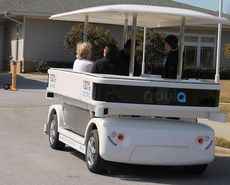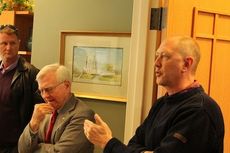
Jim Fair
A touch screen display illustrates the stops for the driverless vehicle on the course mapped by GPS. Users can summon the shuttle with their smart phones.

Jim Fair
Passengers are shuttled around a designated course at the Cottages at Brushy Creek at 12.5 miles per hour.

Jim Fair
Founders of the Navia 100 and community leaders discuss the fully electric vehicle that can be recharged by induction – using magnetic fields – without the need for cables or human intervention, allowing it to be self-sufficient and run 24 hours a day.
A touch screen display illustrates the stops on the course mapped by GPS. Users can summon the shuttle with their smart phones. Navia has zero emissions, can travel at 12.5 mph and carry up to eight passengers. It is fully electric and recharged by induction – using magnetic fields – without the need for cables or human intervention, allowing it to be self-sufficient and run 24 hours a day.
The current price tag: $250,000.
The shuttle has been used in pedestrian-heavy or industrial sites and on college campuses. It is suited for airports, theme parks and shopping complexes. The Greer Memorial Hospital campus provided a venue for visitors from CU-ICAR to see the advanced robotic vehicle using laser mapping technology and sensors that detect the vehicle's acceleration and rotation.
Navia instantly calculates its position, nearby obstacles, route and distance traveled in real time, enabling it to carry its passengers quickly, safely and efficiently. Navia can weave around pedestrians as it carries as many as eight people. It stops when animals or obstacles are in its path.